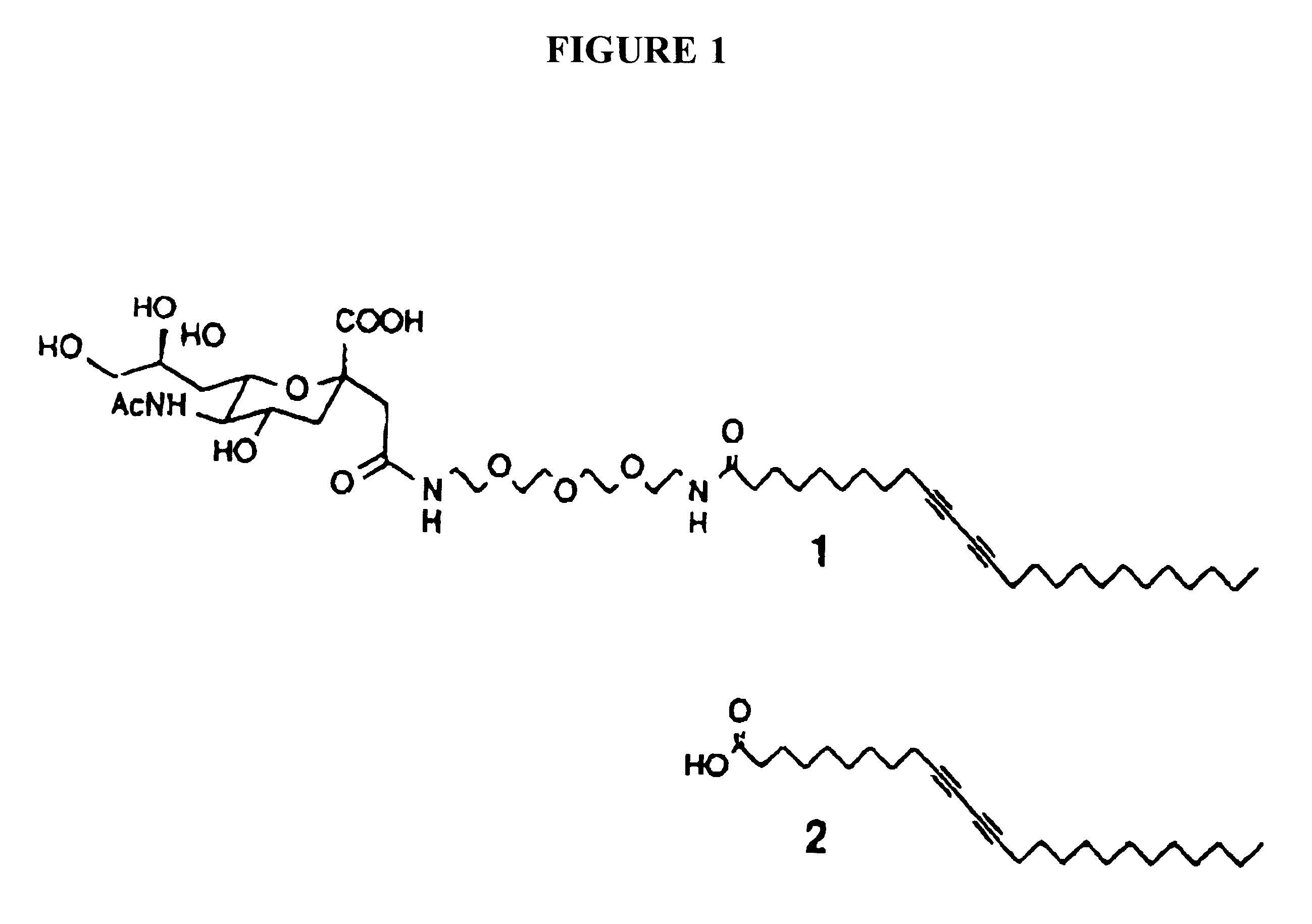Three-dimensional colorimetric assay assemblies
a colorimetric assay and assembly technology, applied in the field of three-dimensional colorimetric assay assemblies, can solve the problems of limited or no practical applicability of analytical chemistry methods to many biological parameters, large quantities of analytes are generally required, and limited quantitative results are limited or not available, and achieves limited applicability, minimal variability, and high genetic conservation over time
- Summary
- Abstract
- Description
- Claims
- Application Information
AI Technical Summary
Benefits of technology
Problems solved by technology
Method used
Image
Examples
example 2
The specific nature of the interaction between the influenza virus and the sialic acid liposomes was confirmed by a competitive inhibition experiment. Incubation of a liposome solution (10% sialic acid lipid 1) with 54 HAUs of influenza virus yields a CR of 31% for blue and 70% for purple liposomes. Performing the same experiment with a slight excess of .alpha.-O-methyl-neuraminic acid, a known inhibitor for influenza virus hemagglutination, results in no color change.
Kinetic experiments show that the color change induced by the addition of an aliquot of virus reaches a plateau after 30 min. although the change becomes apparent within 5 min. For a given polymerization time, the CR depends on the amount of added virus, as shown in FIG. 4. This figure is the plot of the colorimetric response of a purple liposome solution (5% sialic acid lipid 1, 24 min UV) versus successive additions of influenza virus. The liposomes were incubated for 30 min following each addition of virus, and the ...
example 3
Immobilizing Liposomes to Substrates
Attachment to membranes of poly(ether urethanes) or polyacrylonitrile. These membranes are porous, hydrophilic and can be used for affinity separations or immunodiagnosis. The liposomes can be coupled to these membranes by first attaching to the membrane an activating group such as imidizolyl-carbonyl, succinimido, FMP or isocyanate which adds rapidly to nucleophiles in the liposomes such as --NH2, --SH, --OH. Thus, any liposome preparation which contains these functionalities can be directly attached to the membrane. This procedure is analogous to the coupling of proteins to membranes the latter of which can be found in the literature. (C. H. Bamford, K. G. Al-I,amee, M. D. Purbrick, T. J. Wear, J. Chromatography, 1992, 606, 19 or C. H. Bamford, K. G. Allamee, Clinical Materials, 1992, 10, 243. In principle, any strategy previously developed to immobilize proteins can be used to immobilize liposomes.
Liposomes which have an --SH functionality can ...
example 4
Detection and Screening
The liposomes can be used to replace standard radiolabel assays for ligand-receptor screening. For example, if the ligand is an analog of dopamine (e.g. the compound "spiperone"), the ligand can be incorporated into polymerized liposomes (polymerized assemblies). If the membrane receptor for dopamine, such as the dopamine D-2 receptor is added to the spiperone-modified liposomes, a color change from blue to pink is observed. This can be monitored spectroscopically in a manner similar to the detection of viruses and bacteria. The effect can be inhibited by the addition compounds which bind as strongly or stronger than dopamine or spiperone. By using a 96-well plate format, 96 compounds which are analogs of dopamine can be screened as potential new drugs. This high throughput screening does not require the use of expensive radiolabelled compounds and does not have the associated health and safety problems.
Procedure: Dilute 20-50 uL of liposome solution which con...
PUM
| Property | Measurement | Unit |
|---|---|---|
| temperatures | aaaaa | aaaaa |
| temperatures | aaaaa | aaaaa |
| temperatures | aaaaa | aaaaa |
Abstract
Description
Claims
Application Information
 Login to View More
Login to View More - R&D
- Intellectual Property
- Life Sciences
- Materials
- Tech Scout
- Unparalleled Data Quality
- Higher Quality Content
- 60% Fewer Hallucinations
Browse by: Latest US Patents, China's latest patents, Technical Efficacy Thesaurus, Application Domain, Technology Topic, Popular Technical Reports.
© 2025 PatSnap. All rights reserved.Legal|Privacy policy|Modern Slavery Act Transparency Statement|Sitemap|About US| Contact US: help@patsnap.com

